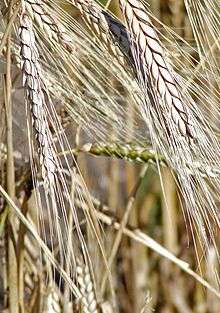Ancient grains
Ancient grains are a grouping of grains and pseudocereals that are considered to have been little changed by selective breeding over recent millennia, as opposed to more widespread cereals such as corn, rice and modern varieties of wheat, which are the product of thousands of years of selective breeding. Ancient grains are often marketed as being healthier than modern grains, though their health benefits have been disputed by some nutritionists.[1][2]
Ancient grains include the grains spelt, Khorasan wheat (Kamut), millet, barley, teff, oats, freekeh, bulgur, sorghum, Farro, einkorn, and emmer; and the pseudocereals quinoa, amaranth, buckwheat, and chia.[1][2][3][4][5][6] Modern wheat is a hybrid descendant of three wheat varieties considered to be ancient grains: spelt, einkorn, and emmer.[2][3]
History
The origin of grains goes back the Neolithic Revolution about 10,000 years ago, when prehistoric communities started to make the transition from hunter-gatherer to farmer. Modern varieties of grains have been developed over time through mutation, selective cropping, breeding and research in biotechnology.[7][8] Ancient grains, however, are said to be largely unchanged from their initial domesticated varieties.[1]
Several ancient grains were worshipped and used by many ancient civilizations, from the Aztecs to the Greeks and Egyptians.[9] Quinoa was called the "mother of all grains" and considered sacred by the Inca people.[8] Amaranth was likewise considered sacred by the Aztecs, and was used as part of a religious ceremony, its cultivation being banned by Spanish colonial authorities.[10] Farro grains are mentioned in the Old Testament.[6][11]
The first reference to ancient grains as a health food was in Daily News (New York) in 1996.[4] Since then the popularity of ancient grains as a food has increased,[2] and in 2011 the gluten-free food market was valued at $1.6 bn.[8] In 2014, the American company General Mills launched a product containing "ancient grains" called "Cheerios + Ancient Grains".[4][5]
Health benefits
Proponents of ancient grains say that they are rich in protein, omega-3 fatty acids and antioxidants.[1] Some nutritionists state that they are not inherently more healthy than modern grains, and that ancient and modern grains have similar health benefits when eaten as whole grains.[1][12] This has led to criticism of the grouping as unscientific and driven by marketing.[4][5]
Some, but not all, ancient grains are gluten-free. Amaranth, quinoa, buckwheat, millet, and teff are gluten-free, but oats and the ancient wheats, including spelt, einkorn, and Khorasan wheat, are not.[1][12]
Gallery
-

Khorasan wheat (Kamut)
See also
References
- 1 2 3 4 5 6 "Ancient grains: The best thing since sliced bread?". Los Angeles Times. 19 February 2011. Retrieved 22 October 2015.
- 1 2 3 4 Joanna Jolly (16 December 2014). "Why do Americans love ancient grains?". BBC News. Retrieved 19 October 2015.
- 1 2 "Know Your Heirloom and Ancient Grains". The New York Times. 13 March 2015. Retrieved 22 October 2015.
- 1 2 3 4 Dan Charles (8 December 2014). "'Ancient Grains' Go From Fringe Food To New Cheerios Variety : The Salt". NPR. Retrieved 22 October 2015.
- 1 2 3 "Why We're Willing to Pay More for Cereals with Ancient Grains". The New Yorker. 24 October 2014. Retrieved 22 October 2015.
- 1 2 Zevnik, Neil (7 January 2014). "Ancient Grains: Everything Old Is New Again". Huffingtonpost.com. Retrieved 13 November 2015.
- ↑ Shewry, P. R. (2009). "Wheat". Journal of Experimental Biology. 60 (6): 1537–1553. doi:10.1093/jxb/erp058.
- 1 2 3 Cooper, Raymond (July 2015). "Re-discovering ancient wheat varieties as functional foods". Journal of Traditional and Complementary Medicine. 5 (3): 138–143. doi:10.1016/j.jtcme.2015.02.004.
- ↑ Sullivan, Rebecca (17 January 2014). "Ancient grains: why you should eat these six superfoods eaten by the Aztec". News.com.au. Retrieved 13 November 2015.
- ↑ Maisto, Michelle (5 December 2011). "Rediscovering Amaranth, The Aztec Superfood". Forbes. Retrieved 13 November 2015.
- ↑ Amy Brown (1 June 2010). Understanding Food: Principles and Preparation. Cengage Learning. p. 354. ISBN 1-133-00838-0.
- 1 2 Storrs, Carina (18 May 2015). "'Natural,' other food labels that may not be legitimate". CNN. Retrieved 13 November 2015.




.jpg)